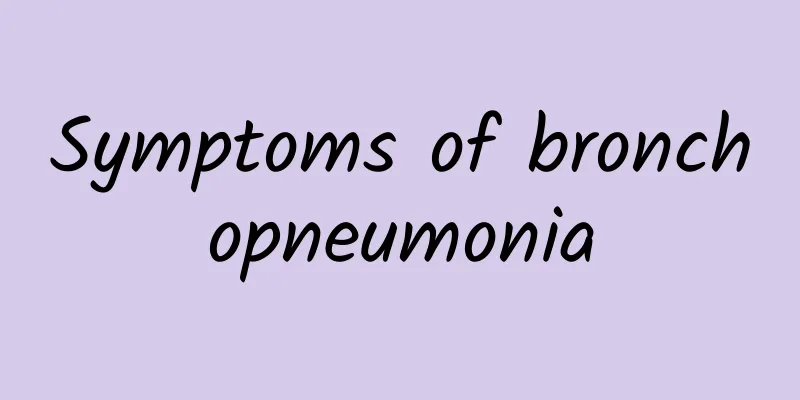Symptoms of bronchopneumonia

|
Pneumonia is clinically divided into many different types, such as viral pneumonia, asthmatic pneumonia, mycoplasma pneumonia and bronchopneumonia. Among the different types of pneumonia, bronchopneumonia is the most difficult to treat and its harm is also the most serious. Therefore, the best way to treat bronchial pneumonia is to detect it early and treat it early to reduce its harm. However, if you want to detect bronchopneumonia as early as possible, you first need to have a comprehensive understanding of the symptoms of bronchopneumonia. And because the disease generally occurs in children, mothers can only analyze based on the baby's symptoms if they understand the symptoms of bronchopneumonia. 1. The early body temperature is mostly between 38 and 39 degrees Celsius, and can be as high as around 40 degrees Celsius. Most of the time, it is a recurrent or regular fever. Most weak infants have a slow onset of illness, with low fever, and no obvious cough or lung signs. Common symptoms include food refusal, choking, vomiting or difficulty breathing. 2. Sudden onset of symptoms include fever, refusal to eat or vomiting, drowsiness or irritability, shortness of breath, etc. There may be a mild upper respiratory tract infection for several days before the onset of the disease. 3. Symptoms and signs of the respiratory system: cough and phlegm in the throat, which are usually obvious in the early stages. Dyspnea is common. In severe cases, there is groaning during exhalation, flaring of the nostrils, three-depression sign, and bluish nails around the mouth. 4. Chest signs are often not obvious in the early stages, or only the breath sounds become coarser or slightly reduced. Later, medium and coarse moist rales can be heard, with slight percussion dullness. After a few days, fine moist rales or crackles may be heard. The symptoms of bronchopneumonia may develop suddenly or slowly, and most cases are preceded by a mild upper respiratory tract infection. In mild cases, there is first a runny nose, mild cough, low fever, and poor appetite, followed by a sudden high fever of 38-39°C after 1 to 3 days, with the cough worsening and shortness of breath leading to the onset of the disease. There are also cases in which the disease is preceded by a sudden fever, cough, shortness of breath, and irritability. Most weak infants have a slow onset of illness, with low fever, and no obvious cough and lung signs. They often refuse to eat, choke on milk, vomit, or have difficulty breathing. After knowing the symptoms of bronchopneumonia, patients need to pay attention to the fact that when treating bronchopneumonia, they must pay attention to lung care and prevent complications and secondary infections. Because the disease is more likely to occur in winter and spring, they must pay attention to preventing the disease in these two seasons. |
<<: How to improve sleep quality
>>: How to treat seborrheic dermatitis
Recommend
What causes acne around the lips?
Having a lot of pimples around the lips can be ve...
What are the symptoms of calcium overdose?
Calcium should be supplemented in time when calci...
Causes of white madness
Vitiligo is a skin disease that mainly occurs on ...
Why do teenagers grind their teeth? Six common reasons
Many people have symptoms of teeth grinding when ...
What should I do if the edges of my teeth become transparent?
Teeth are critical to oral health, and problems w...
Side effects of drospirenone ethinyl estradiol tablets
When women reach their childbearing age but do no...
Symptoms of excessive muscle tension
Hypertonia may occur at every stage. We should pa...
Parkinson's disease treatment with traditional Chinese medicine
In recent years, more and more elderly people hav...
Baby shivers while feeding
There are many reasons why babies tremble while fe...
What is anal prolapse?
Rectal prolapse is a relatively common anorectal ...
Acute suppurative tonsillitis
When it comes to acute suppurative tonsillitis, p...
Do you know what happens after cupping? This result is scary.
Since cupping and scraping are common health-pres...
What if the lochia is clean and there is blood again after cesarean section?
For women who have undergone cesarean section, it...
What is the pain on the left side of the anus and navel?
Pain on the left side of the anus and navel is ge...
Why does jaw pain occur?
The jaw plays many roles in the human body. It ca...









